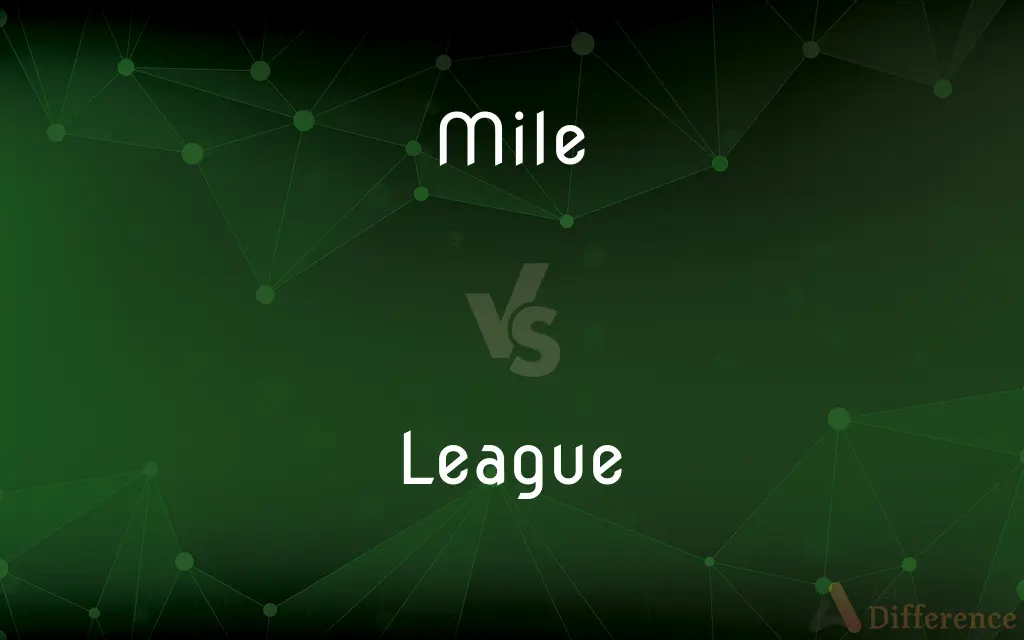Mile vs. League — What's the Difference?
By Urooj Arif & Fiza Rafique — Updated on March 26, 2024
A mile is a unit of length equal to 5,280 feet or approximately 1,609 meters, used mainly in the United States, while a league traditionally represents a distance of about three miles, varying historically and by region.

Difference Between Mile and League
Table of Contents
ADVERTISEMENT
Key Differences
The mile is a standard unit of length primarily used in the United States, the United Kingdom, and a few other countries, defined as exactly 5,280 feet or about 1,609 meters. It is a key part of the imperial and US customary systems. On the other hand, a league is an old unit of distance that was used to represent the distance a person could walk in an hour. Historically, it was defined differently in various places but is commonly understood to be approximately three miles or about 4,828 meters.
In terms of usage, the mile is widely used today for road distances, athletic events like running, and measuring speed in miles per hour. Whereas, the league is now mostly used in historical contexts or in literature to convey large distances, as it is not a standard measurement in modern times.
When it comes to precision, the mile has a well-defined length and is used in scenarios requiring exact measurements, including legal and engineering contexts. In contrast, the league's length was never standardized to the same degree and varied from one place to another, making it less precise for modern use.
The mile is part of daily life in countries like the United States, influencing everything from driving speeds to athletic events. The league, however, has largely fallen out of everyday use and is now primarily found in historical documents, maritime contexts, and literary works, evoking a sense of vast, undefined distances.
Both units reflect the ways societies have measured and conceptualized distance, with the mile remaining relevant in contemporary measurement systems, while the league serves as a reminder of the varied and evolving nature of human scales of distance.
ADVERTISEMENT
Comparison Chart
Definition
A unit of length equal to 5,280 feet or approximately 1,609 meters.
A traditional unit of distance, about three miles or 4,828 meters.
Current Usage
Widely used in the United States, the UK, and for athletic events.
Mostly historical or literary, rarely used in modern measurements.
Precision
Precisely defined and used where exact measurements are needed.
Historically variable and not precise for modern standards.
Standardization
Standardized in the imperial and US customary systems.
Never standardized; varied historically and by region.
Contextual Relevance
Essential for daily life in certain countries, legal systems, and sports.
Primarily of historical interest or used for literary effect.
Compare with Definitions
Mile
A unit of length in the imperial system.
The race was 5 miles long.
League
A historical unit of distance.
The village is a league away from the castle.
Mile
A part of legal and survey measurements.
The property extends for 2 miles.
League
Often used in maritime contexts.
The ship sailed twenty leagues.
Mile
A standard measure in athletics.
He runs the mile in under 4 minutes.
League
Symbolic of large, vague distances.
He would travel leagues to see her.
Mile
Used for measuring distances on land.
The next town is 10 miles away.
League
Varied in length historically.
In France, a league was roughly 4 kilometers.
Mile
Used in expressions of distance or travel.
They walked miles to find help.
League
Found in literature to describe journeys.
They journeyed leagues to reach the mountain.
Mile
The mile, sometimes the international mile or statute mile to distinguish it from other miles, is a British imperial unit and US customary unit of distance; both are based on the older English unit of length equal to 5,280 English feet, or 1,760 yards. The statute mile was standardised between the British Commonwealth and the United States by the international agreement in 1959, when it was formally redefined with respect to SI units as exactly 1,609.344 metres.
League
An association of states, organizations, or individuals for common action; an alliance.
Mile
A unit of linear measure equal to 1,760 yards (approximately 1.609 kilometres).
League
(Sports) An association of teams or clubs that compete chiefly among themselves. Also called loop1.
Mile
A very long way or a very great amount
Vistas which stretch for miles
This is my favourite film by a mile
League
A class or level of competition
The ski jump was out of his league.
Mile
By a great amount or a long way
The second tape is miles better
League
A unit of distance equal to 3.0 statute miles (4.8 kilometers).
Mile
Abbr. mi. or mi A unit of length equal to 5,280 feet or 1,760 yards (1,609 meters), used in the United States and other English-speaking countries. Also called land mile, statute mile. See Table at measurement.
League
Any of various other units of about the same length.
Mile
A nautical mile.
League
A square league.
Mile
An air mile.
League
To come together in or as if in a league.
Mile
(Sports) A race that is one mile long.
League
To bring together in or as if in a league.
Mile
A relatively great distance
Had to walk for miles in the airport.
League
A group or association of cooperating members.
The League of Nations
Mile
The international mile: a unit of length precisely equal to 1.609344 kilometers established by treaty among Anglophone nations in 1959, divided into 5,280 feet or 1,760 yards.
Turn left in 1.2 miles.
League
(sports) An organization of sports teams which play against one another for a championship.
My favorite sports organizations are the National Football League and the American League in baseball.
Mile
Any of several customary units of length derived from the 1593 English statute mile of 8 furlongs, equivalent to 5,280 feet or 1,760 yards of various precise values.
League
Ellipsis of rugby league
Are you going to watch the league tonight?
Mile
Any of many customary units of length derived from the Roman mile (mille passus) of 8 stades or 5,000 Roman feet.
League
(negative polarity) A class or type of people or things that are evenly matched or on the same level.
Forget about dating him; he's out of your league.
We're not even in the same league.
Mile
The Scandinavian mile: a unit of length precisely equal to 10 kilometers defined in 1889.
League
A prefecture-level administrative unit in Inner Mongolia (Chinese: 盟).
Mile
Any of many customary units of length from other measurement systems of roughly similar values, as the Chinese (里) or Arabic mile (al-mīl).
League
(military) An alliance or coalition.
Mile
(travel) An airline mile in a frequent flyer program.
League
(measurement) The distance that a person can walk in one hour, commonly taken to be approximately three English miles (about five kilometers).
Mile
(informal) Any similarly large distance.
The shot missed by a mile.
League
A stone erected near a public road to mark the distance of a league.
Mile
(slang) A race of 1 mile's length; a race of around 1 mile's length (usually 1500 or 1600 meters)
The runners competed in the mile.
League
(ambitransitive) To form an association; to unite in a league or confederacy; to combine for mutual support.
Mile
(slang) One mile per hour, as a measure of speed.
Five miles over the speed limit
League
A measure of length or distance, varying in different countries from about 2.4 to 4.6 English statute miles of 5,280 feet each, and used (as a land measure) chiefly on the continent of Europe, and in the Spanish parts of America. The marine league of England and the United States is equal to three marine, or geographical, miles of 6080 feet each.
Mile
A certain measure of distance, being equivalent in England and the United States to 320 poles or rods, or 5,280 feet.
League
A stone erected near a public road to mark the distance of a league.
Mile
A unit of length equal to 1760 yards
League
An alliance or combination of two or more nations, parties, organizations, or persons, for the accomplishment of a purpose which requires a continued course of action, as for mutual defense, or for furtherance of commercial, religious, or political interests, etc.
And let there be'Twixt us and them no league, nor amity.
Mile
A unit of length used in navigation; equivalent to the distance spanned by one minute of arc in latitude; 1,852 meters
League
An association of sports teams that establishes rules of play, decides questions of membership in the league, and organizes matches between the member teams. In some cases a sports league is called a conference, as in the National Football Conference.
Mile
A large distance;
He missed by a mile
League
To unite in a league or confederacy; to combine for mutual support; to confederate.
Mile
A former British unit of length once used in navigation; equivalent to 1828.8 meters (6000 feet)
League
To join in a league; to cause to combine for a joint purpose; to combine; to unite; as, common interests will league heterogeneous elements.
Mile
A British unit of length equivalent to 1,853.18 meters (6,082 feet)
League
An association of sports teams that organizes matches for its members
Mile
An ancient Roman unit of length equivalent to 1620 yards
League
An association of states or organizations or individuals for common action
Mile
A Swedish unit of length equivalent to 10 km
League
An obsolete unit of distance of variable length (usually 3 miles)
Mile
A footrace extending one mile;
He holds the record in the mile
League
Unite to form a league
Common Curiosities
Why isn't the league used anymore?
The league has fallen out of regular use due to its lack of standardization and the adoption of the metric system in many parts of the world.
What replaced the league in modern measurements?
The metric system, which uses kilometers, has largely replaced the league and other non-standard units in modern measurements.
Can miles and leagues be converted?
Yes, miles and leagues can be converted, with one league traditionally considered to be about three miles, though historical variations exist.
How did people measure leagues historically?
Historically, leagues were measured based on the distance a person could walk in an hour, making the measure somewhat subjective and variable.
What is a mile?
A mile is a unit of length equal to 5,280 feet or about 1,609 meters, commonly used in the United States and the UK for measuring distances.
How long is a league?
Traditionally, a league is about three miles or approximately 4,828 meters, though its exact length varied historically and by region.
Where is the mile used?
The mile is used in countries that follow the imperial system or US customary measures, especially for road distances, sports, and legal documentation.
Are miles used in nautical measurements?
Miles are used in nautical measurements, but as nautical miles, which are different from the land mile and measure approximately 1,852 meters.
Is the league still used today?
The league is rarely used in practical measurements today and is more commonly found in historical or literary contexts.
Which is longer, a mile or a league?
A league is traditionally longer than a mile, with one league being approximately equal to three miles.
Share Your Discovery

Previous Comparison
Whew vs. Phew
Next Comparison
Oxide vs. OxygenAuthor Spotlight
Written by
Urooj ArifUrooj is a skilled content writer at Ask Difference, known for her exceptional ability to simplify complex topics into engaging and informative content. With a passion for research and a flair for clear, concise writing, she consistently delivers articles that resonate with our diverse audience.
Co-written by
Fiza RafiqueFiza Rafique is a skilled content writer at AskDifference.com, where she meticulously refines and enhances written pieces. Drawing from her vast editorial expertise, Fiza ensures clarity, accuracy, and precision in every article. Passionate about language, she continually seeks to elevate the quality of content for readers worldwide.















































